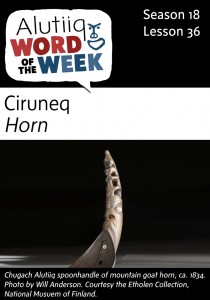 Ciruneq – Horn
Ciruneq – Horn
Una luuskaaq cirunemk canamauq. – This spoon is made from horn.
In the Alutiiq language the words for horn and antler are the same–ciruneq. Like antler, horn is a hard but flexible material that grows from an animal’s heads. Typically found in pairs, horns feature a core of bone covered with a hard layer of keratinized skin. The quality of the material depends on the type of animal and its condition. Healthy animals produce strong, elastic horn that can be made into beautiful objects.
In Prince William Sound and on the Kenai Peninsula, Alutiiq people harvested the horns of mountain goats. Both male and female goats have horns that grow continuously, laying down new rings of keratin each year. These horns are short–just 8 to 12 inches long, sharply pointed, and gently curved. From this material, craftsmen fashioned elegant spoons.
The first step in working horn is to clean out the spongy, blood rich, inner corn, a messy job that can be accomplished with a combination of soaking, scraping, or aging the horn. With a clean piece of material, carvers can season the material and work it dry, or soften the horn by soaking. Alutiiq methods of working horn are not recorded. However, they were probably similar to those of the neighboring Tlingit people, who also manufactured horn spoons. Tlingit carvers spit mountain goat horns in half, boil the pieces, soak them in oil, and then mold them to a desired shape. When it was time to carve, craftsman use warm water to soften the material. The final step was to buff the carving to create a shinny surface.
However they were made, Alutiiq horn spoons are works of art. Known in Alutiiq as alungun, from the root word for licking, theses spoons featured intricately carved handles with stacks of human and animal figures. On the wide shallow bowl, artists incised geometric designs and added inlays. Historic examples features tiny white glass beads set into the bowl. These elaborate decorations suggest that horn spoons were used in ceremonies, perhaps in combination with decorated wooden feast bowls.
Source: Alutiiq Museum [xyz-ihs snippet=”Adsense-responsive”]







